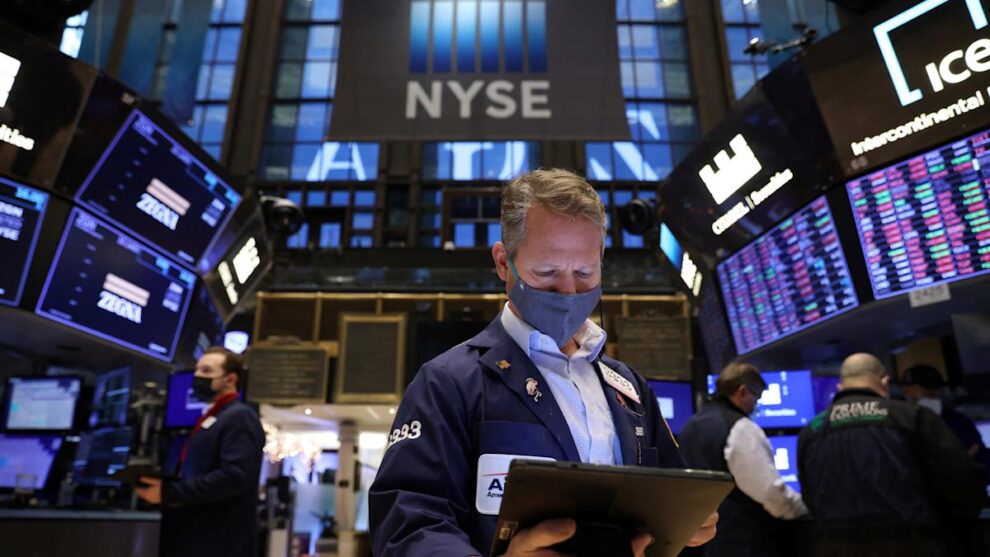
Technology stocks came under renewed pressure on Wednesday while the Dow Jones Industrial Average pulled back from a fresh record high. Darrell Cronk, Wells Fargo CIO of Wealth & Investment Management and Sam Stovall, CFRA Chief Investment Strategist joined Yahoo Finance Live to discuss.
Video Transcript
– All right. We’re roughly a minute and 15 seconds to the closing bell. Let’s introduce the panel that’s going to help us understand what’s transpired today. And then we’re going to talk a little bit about where we are as we head into the closing numbers. Darrell Cronk is Wells Fargo’s CIO of wealth and investment management. Sam Stovall, always good to see both of you. CFRA chief investment strategist. Let’s take a look at where we’re setting up because with roughly 45 seconds to go, we’ve got the Dow off about 1%. The S&P 500 is off almost 2%. And the NASDAQ is off a little bit more than 3%.
Jared and I were joking about the taper tantrum back in, what was it, 2012, 2013, Mr. Bernanke’s problems that sent markets down a little bit more dramatically than what we’re witnessing here. But it was those Fed minutes in which, you know, I guess you could call it the roll off rage, helped drive things down. And one thing to look at. When you talk about sector action, information technology down almost 3% today. But within there, software companies down a little bit more than 4%. So we’re keeping an eye on all of this as we gear up for the closing bell, which will ring in roughly 3, 2, 1. Go for it.
[BELL RINGING]
– And that is the closing bell this Wednesday, January 5. Let’s take a look at where markets are looking like they’ll be settling today. We had a little bit of an acceleration in this sell off into the close, especially in tech stocks. Now, take a look at the NASDAQ. Down now about 3.3%. The Dow off more than 380 points, or about 1%. And the S&P 500 is down nearly 2% during today’s session. Now let’s go back to our market panel to make sense of the moves that we’re seeing this afternoon. Darrell, I’ll start with you on this one. Now, this was a major move to the downside on the NASDAQ today and for tech stocks broadly. Is this a tech buying opportunity for investors, or is there more volatility ahead based on what we’ve heard from the Fed?
DARRELL CRONK: There’s probably more volatility coming off of a pretty strong 2021. We actually like tech for all of 2022 in our outlook. But there’s no doubt that tech is going to kind of take it on the chin when the yield curve does what it does and the Fed meeting minutes suggest that long duration assets like tech or things like REITs that are interest rate-sensitive really come under pressure in moments where you believe that the Fed is going to take a much more hawkish stance based off of the read of the minutes.
– Sam, on a day like this, a lot of us think of Kevin Bacon in that dramatic classic “Animal House.” Remain calm. All as well. But you like to point out that last year we saw, what, 70 new all-time highs on the S&P 500. And what does that usually set us up for in the following year?
SAM STOVALL: Well, thank you sir. May I have another? When you think about what the market has done last year and what that sets us up for this year, in a sense, you get a lot of crosscurrents. We had a near 27% price appreciation, 28% for the S&P 500, ranked 12th since World War II. But whenever you’ve had a 20-plus percent gain, the market did pretty well the year after. Up 10 and 1/2%.
And then also the frequency of advance went higher. So I would tend to say that there’s a good chance. But I agree that the volatility is likely to pick up quite a bit because we have now entered the sophomore slump year for the President, the second year in their four year term. And, typically, volatility is 40% higher than the average for the other three years of a presidential cycle.
– Darrell, I want to turn to what we’ve been seeing in the Treasury yield market because that benchmark 10-year yield moving still higher today. Right around 1.7%, about the highest level we’ve seen in nine months. Should investors expect to continue seeing rates to increase here, at least on Treasury yields, or is this just a little bit of a short-term move to the upside?
DARRELL CRONK: No. We think actually Treasury yields are going to kind of slowly grind their way higher. And you could make a very acute argument that without the Fed’s influence rates in a natural state should be higher than they are today. 170 was kind of the– we touched it last fall. But to your earlier point, 177 was the high for all of last year. So 7 basis points away from that. If we break through that, we kind of enter this new regime where rates have to find a new kind of balancing act. And that’s going to– to Sam’s good point– create even more volatility.
I mean, it’s noteworthy that last year was the fourth smallest drawdown that we saw in the S&P 500 since 1987. So volatility was non-existent. We never touched the 200-day moving average once last year for the entire calendar year. So as rates go higher, it’s natural that it’s going to create more volatility to find that new balancing act. And it will be most acute in those rate sensitive sectors like long-duration tech and some of the interest rate sensitive areas.
– Darrell, help us. I just want to follow up on this because I know that you’re worried about inflation, especially when you’re taking a look at something like oil and what we all pay at the pump. If you’re expecting inflation has not yet peaked in what we’re going to be paying for gas and those other kinds of things, how as an investor should I deploy what capital I might have right now, especially on a down day where there might be opportunity? I realize crude was up. But how do I deploy that money?
DARRELL CRONK: That’s a great question. So look, I mean, we don’t think inflation has peaked. Even if you take the consensus estimate of 5/10 of 1% for the CPI for the month of December, which we’ll see here shortly, that puts the year over year headline inflation rate at 7.2, up from 6.8 in November. So, obviously, inflation still lies before us. We move from goods inflation to services inflation. And then it eventually leaks into wage and labor inflation and a natural evolution, if you will, to past business cycles.
The important thing we think is we like commodities. We like real assets. We think they’re going to have a good 2022 just like they had a good 2021. Supply is the issue in the commodity market. So if you’re worried about inflation and you’re worried about how do I hedge against, if not ever higher inflation, certainly higher sustained inflation, most portfolios I look at have an underweight exposure today to commodities and real assets. And that’s a place I think of an opportunity for investors.
– Sam, with the Fed minutes behind us, one of the next big reports we’ll be watching for this week is the December jobs report on Friday. We just got a big beat on ADP’s private payrolls report, that coming in at 807,000, or about double what consensus economists were expecting. What do you expect to see from Friday’s jobs report. And how should investors be bracing for the market action around that?
SAM STOVALL: Well, you’re absolutely right that the ADP number did come in above 800,000, whereas the Street was expecting something south of 400,000. And we’re looking at a similar number for Friday, where payrolls are expected to be about 400,000, unemployment rate at 4.1%. And what we could find is that there was an increased risk of an even higher jump in the number of new jobs, and as a result, a decline in the unemployment rate.
So I think that will possibly add more concerns regarding inflation year on year, questioning whether the peak will come in the first quarter or get pushed further out into this new year. And then I also remind you that there is a negative correlation of 0.5 between the 10-year yield and PE ratios on the S&P 500. So as the 10-year yield creeps higher, as we think as well, possibly hitting 2% by the end of the year, that that could put downward pressure on PE’s.
– Sam just answered the question I was about to ask him. So let me throw it to you, Darrell, because I was curious if you would put a time frame on when we might cross over on the 10 year, that magic number 2. And will it be sustained? Or is it just going to be like what we saw a year ago when we hit 1.77 and then fell back?
DARRELL CRONK: Yeah. It’s a great question. It’s always hard to call the timing on these things. Again, if we break 177, which is the prior highs, we’ve got to find a new kind of technical level to balance ourselves out at. So it’s entirely possible we can push to 2. Moving to 2 in the short term from today’s levels, though, it would be a big move in the short term.
I think there’s a lot of people that were short the Treasury market and then ended up towards year end covering their shorts because of concerns about omicron, spending, slowing the economy and growth down and are now right back on that equation reinstituting those short positions on the Treasury market. So that’s putting undue pressure there. We, like Sam, also think a number of 2 in front of the 10 year is likely, but probably not until the second half of the year this year. I don’t think it’s in the near term. And if it is, it probably means equity prices move lower and we get that correction that we’ve been missing or waiting for for quite some time.
– Darrell Cronk is Wells Fargo’s CIO of wealth and Investment management. Sam Stovall, CFRA chief investment strategist. Gentlemen, you have helped us all reinforce what Emmanuel Favor told us in “Anime House.” Knowledge is good.









